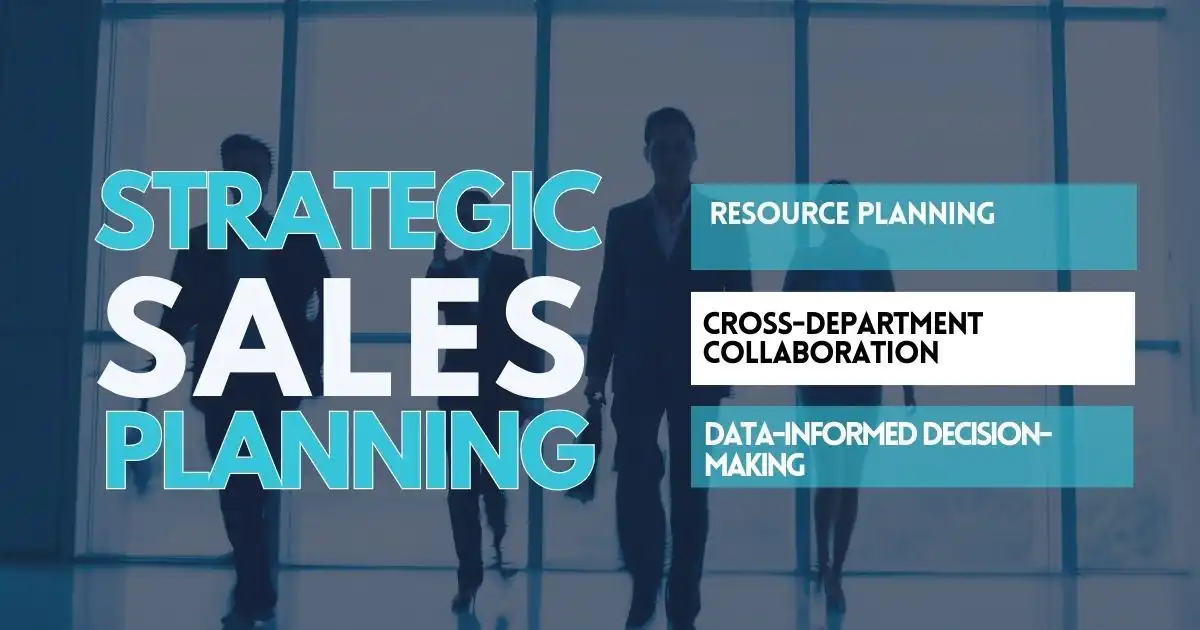Is your business stuck in the confusion of sales planning vs. revenue planning? It’s easy to mix the two up, but getting them right can make or break your business strategy.
The truth is, understanding how they differ can unlock a clearer path to growth and success. But here’s the catch—there’s a lot more to it than meets the eye.
Keep reading to learn what sets them apart and why mastering both can give you a major edge in hitting your goals. Trust me, you’ll want to stick around to find out.
What is Sales Planning?
Sales planning is the process of developing a structured yet flexible strategy that helps a sales team reach its targets within a specific period — usually quarterly or annually. It involves identifying target markets, setting activity plans, assigning resources, forecasting revenue, and aligning budget and personnel with overall business goals.
A well-prepared sales plan not only guides daily sales efforts but also supports long-term business growth by helping leaders track recurring revenue, performance trends, and financial health.
A well-executed sales plan provides clarity, direction, and measurable steps that sales teams can follow. It becomes a roadmap for achieving both short-term wins and long-term business goals, helping to improve consistency and accountability across the sales organization.
Sales Planning vs. Sales Plan
It’s important to understand the difference between a sales plan and sales planning, as they are often confused but serve different purposes:
- A sales plan is a formal document — usually created annually by the sales leader — that outlines sales goals, strategies, and the steps the team will take to meet those goals. It typically includes sales targets, timelines, assigned roles, and performance metrics.
- Sales planning, on the other hand, is an ongoing process. It involves regularly reviewing the sales plan, adjusting strategies, reallocating resources, and responding to market changes as they happen.
With constant shifts in the marketplace, relying solely on an annual sales plan can be limiting. That’s why many businesses now focus on dynamic sales planning — a continuous approach that allows teams to stay agile, make quick decisions, and better align with changing market demands and customer expectations.
Strategic Sales Planning

Strategic sales planning looks beyond day-to-day sales tasks and focuses on the bigger picture. It involves forecasting future sales, anticipating challenges, and preparing the business to grow sustainably over time. Instead of simply reacting to current conditions, strategic planning positions the sales team to act proactively, with a clear vision for what’s ahead.
Main Areas to Consider in Strategic Sales Planning
1. Resource Planning
Identify what tools, people, and budget are needed to reach your sales goals. You also need to understand the assumptions you’re making (e.g., expected demand or market conditions) and recognize possible risks that could impact the plan. Your budget should reflect these needs and help ensure that resources are used efficiently and effectively.
2. Cross-Department Collaboration
Sales planning works best when multiple departments — like marketing, customer support, and product — work together. Marketing can help generate leads, customer service can offer feedback from users, and product teams can ensure offerings meet market demands.
This alignment improves the quality of the sales pipeline and ensures the business is prepared to support new and existing customers.
3. Data-Informed Decision-Making
Good sales planning relies on insights from data. This includes past sales results, customer behavior, product performance, and current market conditions. By analyzing these data points, leaders can set realistic targets, plan campaigns more accurately, and improve the team’s overall productivity.
Important Areas to Focus On During Sales Planning

To build a strong and effective sales plan, businesses should focus on these foundational elements:
- Clear Direction and Vision – Define the overall sales strategy, including goals, sales forecasts, sales methods, team structure, territories, and how customer coverage will be handled. This helps the entire team understand what success looks like and how to get there.
- Sales Tools and Technology – Invest in the right tools to support your sales team. This includes CRM systems, automation platforms, data analytics tools, and communication apps. These technologies streamline operations, reduce manual work, and help teams focus on selling.
- Sales Enablement – Provide your team with everything they need to succeed — from product training and sales scripts to case studies, contract templates, and competitive insights. Well-prepared reps are more confident and close deals faster.
- Performance Review and Problem Solving – Continuously monitor team performance, review metrics, and gather feedback. Use this information to fix issues, spot trends, and improve how the team operates. Sales planning should always leave room for adjustments and improvements.
Benefits of Sales Planning

Sales planning offers a wide range of benefits that support growth, efficiency, and success. Here are some of the most important advantages:
1. Stronger Strategic Direction
It helps identify areas that need improvement, define specific goals, and build action plans to reach those goals. This structured approach helps avoid guesswork and keeps the team focused.
2. Smarter Use of Resources
Through effective planning, companies can allocate time, money, tools, and people where they’re most needed. This reduces waste and boosts return on investment.
3. Realistic and Motivating Goals
Sales planning allows companies to set achievable targets based on past performance, market trends, and current business conditions. This avoids setting goals that are too high or too low and helps keep the sales team motivated and confident.
4. Better Forecasting and Decision-Making
By analyzing past sales data and predicting future trends, businesses can make informed decisions about hiring, marketing, inventory, product development, and more.
5. Improved Sales Performance
With a well-planned strategy and the right tools, sales teams can work more efficiently, close more deals, and build stronger relationships with customers.
What is Revenue Planning?
Revenue planning is about figuring out how much money a business expects to bring in and how that money will be used to run the company and support growth.
While sales planning focuses on setting sales goals and forecasting potential profits, revenue planning looks at the actual money coming into the business. This includes income from products or services sold and how it impacts important financial documents like cash flow and income statements.
Revenue planning isn’t just about managing the money already coming in. It also helps businesses decide where to spend — like hiring new staff, investing in new tools, or improving systems — to support future growth.
By looking at current revenue, sales performance, and market trends, companies can prepare for different business scenarios and make smarter financial decisions.
Teamwork in Revenue Planning

A good revenue plan is built with input from different departments. Everyone — from finance to marketing to operations — needs to work together to make sure the company stays on track. Here’s how to create a strong revenue planning strategy:
1. Align Company Goals
Make sure every team understands the company’s bigger goals. Define what each department needs to do to help reach those goals. Set clear sales and revenue targets with flexible timelines.
2. Build a Detailed Plan
Coordinate with all departments to match your revenue and sales forecasts with production, marketing, and delivery. The goal is to have a complete go-to-market strategy that makes sense for everyone involved.
3. Prepare for Execution
Review what resources you have — such as your budget, tools, and team — and spot any risks or gaps. Make adjustments as needed to avoid delays or problems down the line.
Why Revenue Planning is Important

Here are the major benefits of having a strong revenue planning process:
Better Understanding of Customers
Revenue planning helps businesses learn more about what their customers want. With the right data and analysis, companies can tailor their products, services, and marketing efforts to better meet customer needs.
Smarter Pricing Strategies
By looking at revenue data and market conditions, businesses can set prices that attract customers and stay competitive. This is especially helpful in markets where pricing plays a big role in winning or losing customers.
Opportunity to Enter New Markets
Planning revenue carefully can reveal untapped markets or customer segments. This can open the door to new growth opportunities and allow businesses to reach a wider audience.
Improved Team Collaboration
Revenue planning brings different departments together. Sales and marketing might create the strategy, but it’s the operations and customer service teams that help bring those plans to life. A united approach ensures that everyone is working toward the same outcome.
Important Areas to Focus On in Revenue Planning
When building your revenue plan, pay close attention to these focus points:
- Customer Support and Experience – Make sure teams who interact with customers have the knowledge and tools to deliver a great experience.
- Training and Team Building – Invest in hiring, training, and developing your team to improve how the company works overall.
- Use of Data and Analytics – Analyze customer behavior, preferences, and feedback to make more informed decisions.
- Monitoring Market Trends – Keep an eye on industry changes, customer needs, and broader market shifts to stay ahead of the curve.
Understanding Their Unique Roles

Sales planning focuses on setting specific targets and developing strategies to achieve them, including analyzing past data, forecasting future sales, and allocating resources to enhance the sales team’s performance. In contrast, revenue planning takes a broader view, managing the income generated from sales and other sources to support operational expenses and strategic investments, ensuring alignment with the company’s long-term financial goals.
While sales planning aims to optimize sales effectiveness, revenue planning seeks to enhance overall financial health and growth prospects. Both require cross-departmental collaboration but differ in scope: sales planning is a subset of revenue planning, concentrating on sales activities, whereas revenue planning encompasses a comprehensive view of financial management.
Planning for Success—Don’t Miss the Bigger Picture
Sales planning and revenue planning are like two sides of the same coin. One focuses on hitting targets, while the other ensures the money keeps flowing. But here’s the kicker—getting them right isn’t just about ticking boxes.
It’s about connecting the dots for lasting growth. Sales planning may fuel immediate results, but without a solid revenue plan, you could be leaving money on the table. Think of it like a car: sales planning is your engine, but revenue planning is what keeps you on the road.
Master both, and you’re not just chasing short-term wins; you’re setting up your business for long-term success. So, which one’s your priority today? Start acting on it now!
FAQs
What is the sales planning process?
The sales planning process involves setting sales goals, identifying target markets, and creating strategies to achieve those goals. It also includes forecasting, resource allocation, and ongoing adjustments to stay aligned with business objectives.
Can you provide a revenue plan example?
A revenue plan example includes projections of income from various sources and outlines how that revenue will be spent to support business growth. It also considers market conditions and pricing strategies to ensure accurate forecasting.
What does planning sales involve?
Planning sales involves setting clear goals, developing strategies to meet those goals, and allocating resources effectively. It also includes forecasting sales and continuously adjusting plans based on performance and market changes.
Is sales the same as sales revenue?
No, sales refers to the act of selling products or services, while sales revenue is the income generated from those sales. Sales are the activities, and revenue is the financial result of those activities.
